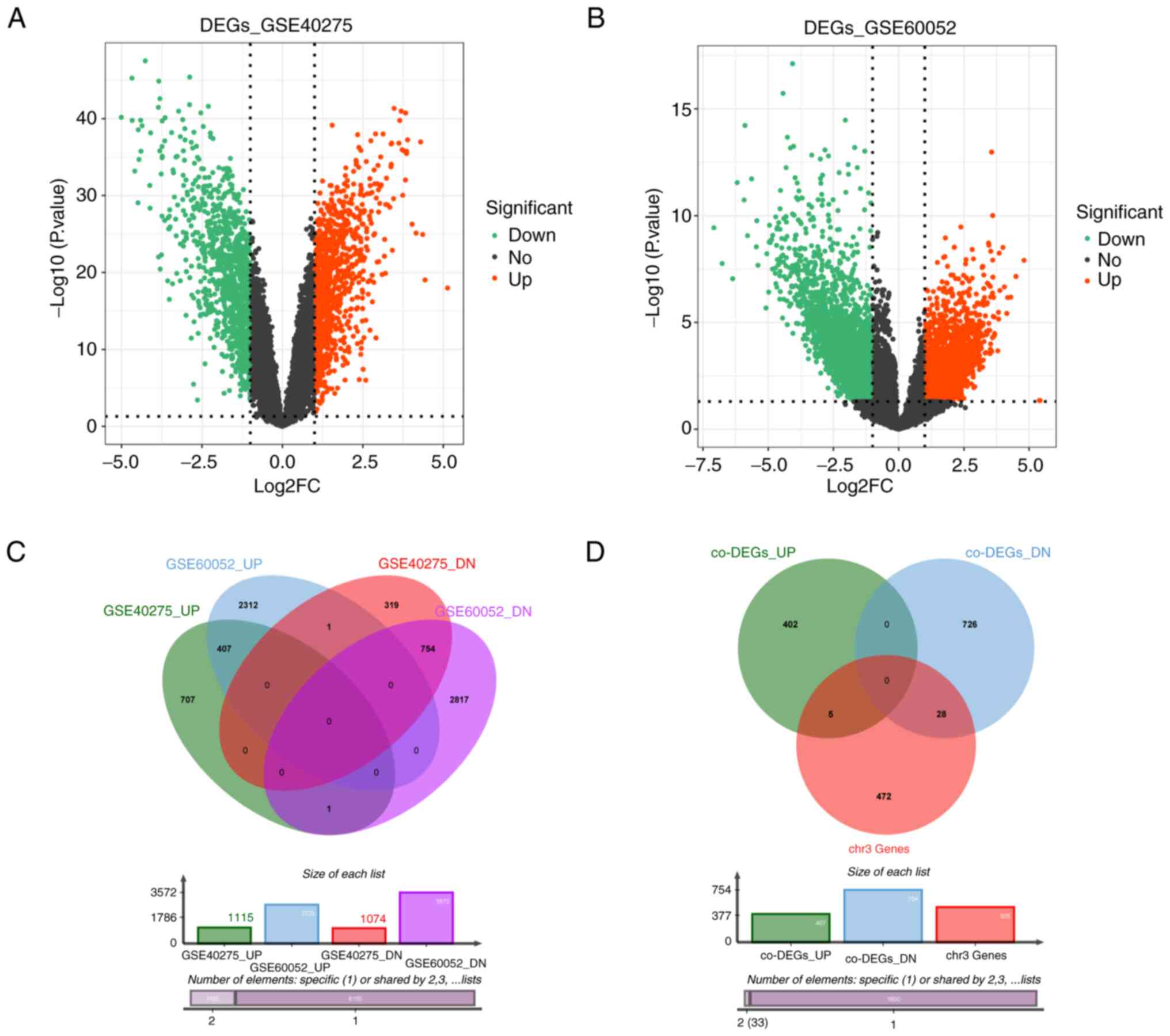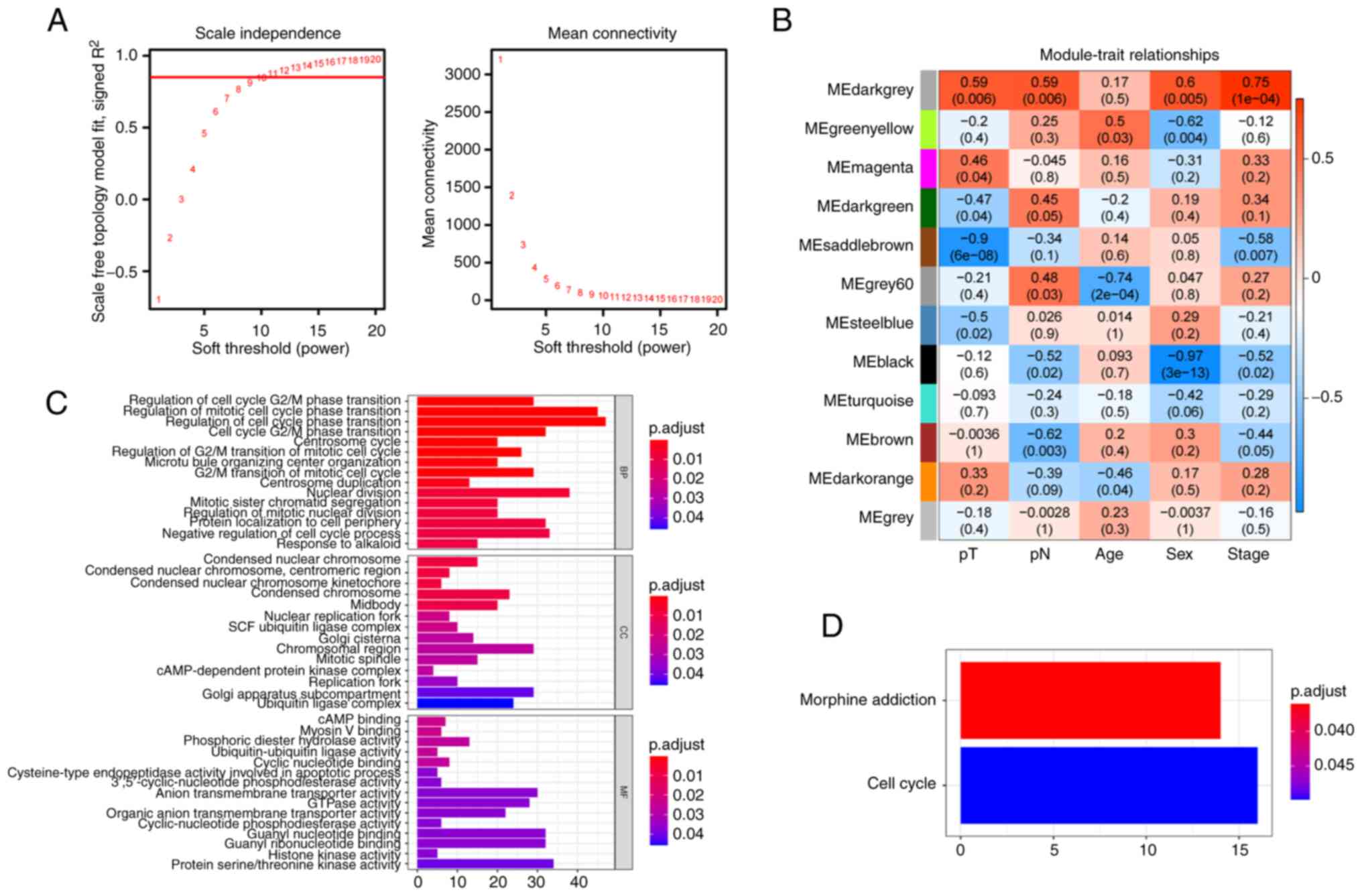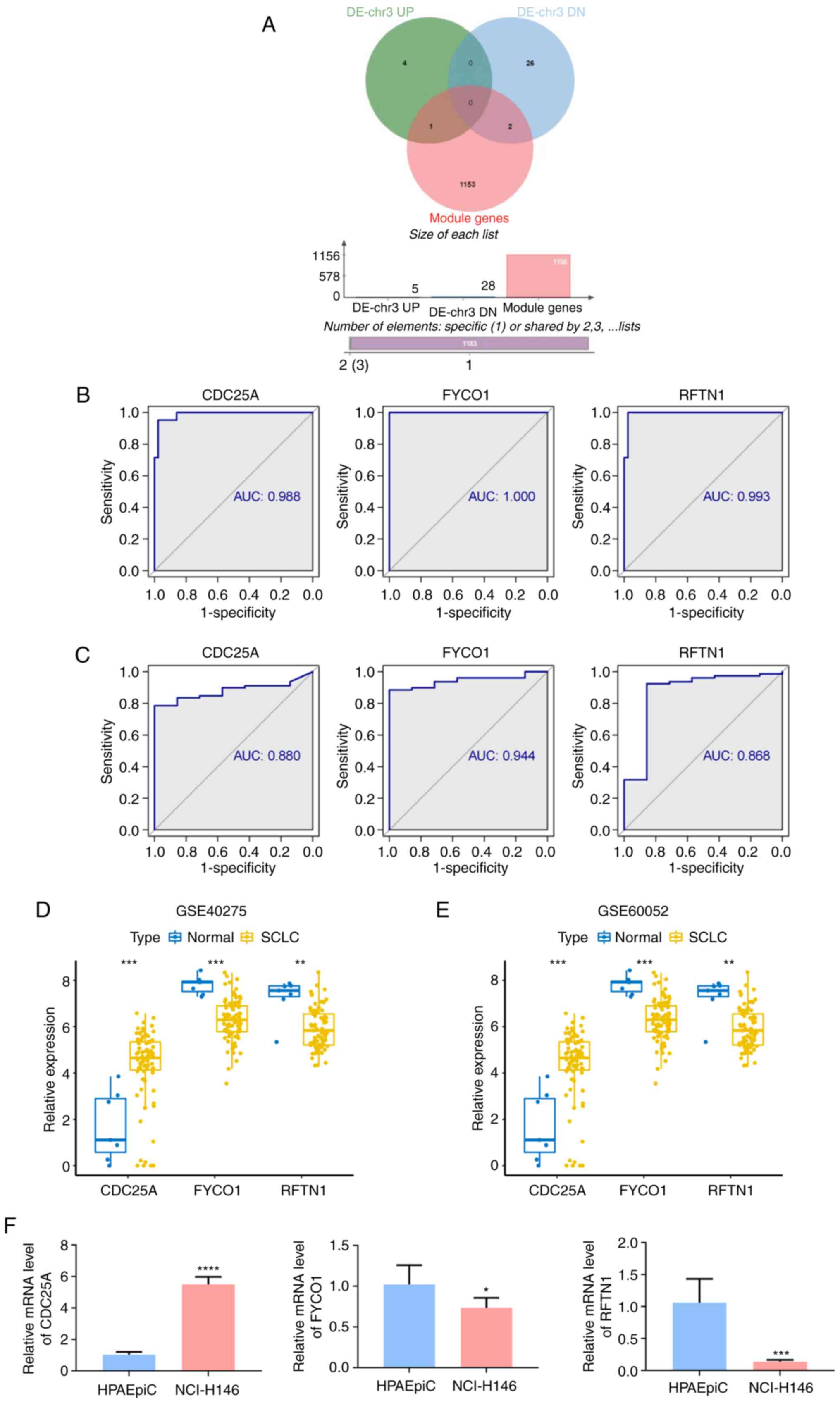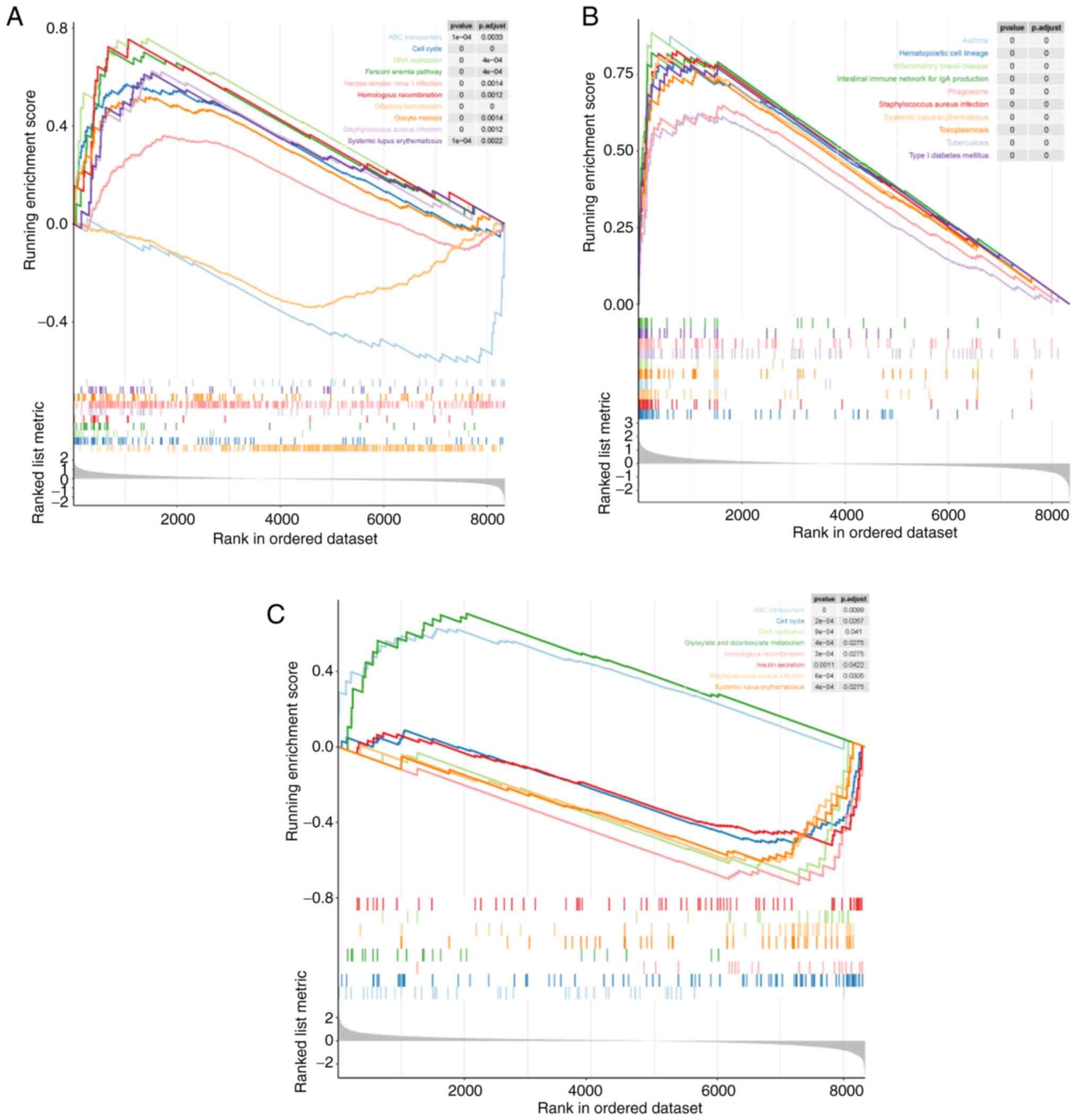|
1
|
Semenova EA, Nagel R and Berns A: Origins,
genetic landscape, and emerging therapies of small cell lung
cancer. Genes Dev. 29:1447–1462. 2015. View Article : Google Scholar : PubMed/NCBI
|
|
2
|
Bray F, Ferlay J, Soerjomataram I, Siegel
RL, Torre LA and Jemal A: Global cancer statistics 2018: GLOBOCAN
estimates of incidence and mortality worldwide for 36 cancers in
185 countries. CA cancer J Clin. 68:394–424. 2018. View Article : Google Scholar : PubMed/NCBI
|
|
3
|
Rudin CM, Brambilla E, Faivre-Finn C and
Sage J: Small-cell lung cancer. Nat Rev Dis Primers. 7:32021.
View Article : Google Scholar : PubMed/NCBI
|
|
4
|
Nicholson AG, Chansky K, Crowley J,
Beyruti R, Kubota K, Turrisi A, Eberhardt WE, van Meerbeeck J,
Rami-Porta R; Staging and Prognostic Factors Committee, ; et al:
The international association for the study of lung cancer lung
cancer staging project: Proposals for the revision of the clinical
and pathologic staging of small cell lung cancer in the forthcoming
eighth edition of the TNM classification for lung cancer. J Thorac
Oncol. 11:300–311. 2016. View Article : Google Scholar : PubMed/NCBI
|
|
5
|
Zamay TN, Zamay GS, Kolovskaya OS, Zukov
RA, Petrova MM, Gargaun A, Berezovski MV and Kichkailo AS: Current
and prospective protein biomarkers of lung cancer. Cancers (Basel).
9:1552017. View Article : Google Scholar : PubMed/NCBI
|
|
6
|
Liu L, Teng J, Zhang L, Cong P, Yao Y, Sun
G, Liu Z, Yu T and Liu M: The combination of the tumor markers
suggests the histological diagnosis of lung cancer. Biomed Res Int.
2017:20139892017.PubMed/NCBI
|
|
7
|
Li YL, Roberts ND, Wala JA, Shapira O,
Schumacher SE, Kumar K, Khurana E, Waszak S, Korbel JO, Haber JE,
et al: Patterns of somatic structural variation in human cancer
genomes. Nature. 578:112–121. 2020. View Article : Google Scholar : PubMed/NCBI
|
|
8
|
Zabarovsky ER, Lerman MI and Minna JD:
Tumor suppressor genes on chromosome 3p involved in the
pathogenesis of lung and other cancers. Oncogene. 21:6915–6935.
2002. View Article : Google Scholar : PubMed/NCBI
|
|
9
|
Weir BA, Woo MS, Getz G, Perner S, Ding L,
Beroukhim R, Lin WM, Province MA, Kraja A, Johnson LA, et al:
Characterizing the cancer genome in lung adenocarcinoma. Nature.
450:893–898. 2007. View Article : Google Scholar : PubMed/NCBI
|
|
10
|
Petursdottir TE, Thorsteinsdottir U,
Jonasson JG, Moller PH, Huiping C, Bjornsson J, Egilsson V, Imreh S
and Ingvarsson S: Interstitial deletions including chromosome 3
common eliminated region 1 (C3CER1) prevail in human solid tumors
from 10 different tissues. Genes Chromosomes Cancer. 41:232–242.
2004. View Article : Google Scholar : PubMed/NCBI
|
|
11
|
Zhou Y, Zhou B, Pache L, Chang M,
Khodabakhshi AH, Tanaseichuk O, Benner C and Chanda SK: Metascape
provides a biologist-oriented resource for the analysis of
systems-level datasets. Nat Commun. 10:15232019. View Article : Google Scholar : PubMed/NCBI
|
|
12
|
The Gene Ontology Consortium, . Expansion
of the gene ontology knowledgebase and resources. Nucleic Acids
Res. 45:D331–D338. 2017. View Article : Google Scholar : PubMed/NCBI
|
|
13
|
Kanehisa M and Goto S: KEGG: Kyoto
encyclopedia of genes and genomes. Nucleic Acids Res. 28:27–30.
2000. View Article : Google Scholar : PubMed/NCBI
|
|
14
|
Fabregat A, Jupe S, Matthews L,
Sidiropoulos K, Gillespie M, Garapati P, Haw R, Jassal B, Korninger
F, May B, et al: The reactome pathway knowledgebase. Nucleic Acids
Res. 46:D649–D655. 2018. View Article : Google Scholar : PubMed/NCBI
|
|
15
|
Schmittgen TD and Livak KJ: Analyzing
real-time PCR data by the comparative C(T) method. Nat Protoc.
3:1101–1108. 2008. View Article : Google Scholar : PubMed/NCBI
|
|
16
|
Sandeep A, Praveen VK, Kartha KK,
Karunakaran V and Ajayaghosh A: Supercoiled fibres of self-sorted
donor-acceptor stacks: A turn-off/turn-on platform for sensing
volatile aromatic compounds. Chem Sci. 7:4460–4467. 2016.
View Article : Google Scholar : PubMed/NCBI
|
|
17
|
Li W, Zhang H, Assaraf YG, Zhao K, Xu XJ,
Xie JB, Yang DH and Chen ZS: Overcoming ABC transporter-mediated
multidrug resistance: Molecular mechanisms and novel therapeutic
drug strategies. Drug Resist Updat. 27:14–29. 2016. View Article : Google Scholar : PubMed/NCBI
|
|
18
|
Chauncey TR: Drug resistance mechanisms in
acute leukemia. Curr Opin Oncol. 13:21–26. 2001. View Article : Google Scholar : PubMed/NCBI
|
|
19
|
Pérez-Tomás R: Multidrug resistance:
Retrospect and prospects in anti-cancer drug treatment. Curr Med
Chem. 13:1859–1876. 2006. View Article : Google Scholar : PubMed/NCBI
|
|
20
|
Zhu MR, Huang Y, Bender ME, Girard L,
Kollipara R, Eglenen-Polat B, Naito Y, Savage TK, Huffman KE,
Koyama S, et al: Evasion of innate immunity contributes to small
cell lung cancer progression and metastasis. Cancer Res.
81:1813–1826. 2021. View Article : Google Scholar : PubMed/NCBI
|
|
21
|
Davis AP, Grondin CJ, Johnson RJ, Sciaky
D, Wiegers J, Wiegers TC and Mattingly CJ: Comparative
toxicogenomics database (CTD): Update 2021. Nucleic Acids Res.
49:D1138–D1143. 2021. View Article : Google Scholar : PubMed/NCBI
|
|
22
|
Liao Y, Yin GF, Wang X, Zhong P, Fan XM
and Huang CL: Identification of candidate genes associated with the
pathogenesis of small cell lung cancer via integrated
bioinformatics analysis. Oncol Lett. 18:3723–3733. 2019.PubMed/NCBI
|
|
23
|
Shen T and Huang S: The role of Cdc25A in
the regulation of cell proliferation and apoptosis. Anticancer
Agents Med Chem. 12:631–639. 2012. View Article : Google Scholar : PubMed/NCBI
|
|
24
|
Sadeghi H, Golalipour M, Yamchi A,
Farazmandfar T and Shahbazi M: CDC25A pathway toward tumorigenesis:
Molecular targets of CDC25A in cell-cycle regulation. J Cell
Biochem. 120:2919–2928. 2019. View Article : Google Scholar : PubMed/NCBI
|
|
25
|
Ray D, Terao Y, Fuhrken PG, Ma ZQ, DeMayo
FJ, Christov K, Heerema NA, Franks R, Tsai SY, Papoutsakis ET and
Kiyokawa H: Deregulated CDC25A expression promotes mammary
tumorigenesis with genomic instability. Cancer Res. 67:984–991.
2007. View Article : Google Scholar : PubMed/NCBI
|
|
26
|
Sengupta S, Jana S and Bhattacharyya A:
TGF-β-Smad2 dependent activation of CDC 25A plays an important role
in cell proliferation through NFAT activation in metastatic breast
cancer cells. Cell Signal. 26:240–252. 2014. View Article : Google Scholar : PubMed/NCBI
|
|
27
|
Brunetto E, Ferrara AM, Rampoldi F,
Talarico A, Cin ED, Grassini G, Spagnuolo L, Sassi I, Ferro A,
Cuorvo LV, et al: CDC25A protein stability represents a previously
unrecognized target of HER2 signaling in human breast cancer:
Implication for a potential clinical relevance in trastuzumab
treatment. Neoplasia. 15:579–590. 2013. View Article : Google Scholar : PubMed/NCBI
|
|
28
|
Albert H, Santos S, Battaglia E, Brito M,
Monteiro C and Bagrel D: Differential expression of CDC25
phosphatases splice variants in human breast cancer cells. Clin
Chem Lab Med. 49:1707–1714. 2011. View Article : Google Scholar : PubMed/NCBI
|
|
29
|
Wang P, Zou F, Zhang X, Li H, Dulak A,
Tomko RJ Jr, Lazo JS, Wang Z, Zhang L and Yu J: microRNA-21
negatively regulates Cdc25A and cell cycle progression in colon
cancer cells. Cancer Res. 69:8157–8165. 2009. View Article : Google Scholar : PubMed/NCBI
|
|
30
|
Butz H, Németh K, Czenke D, Likó I,
Czirják S, Zivkovic V, Baghy K, Korbonits M, Kovalszky I, Igaz P,
et al: Systematic investigation of expression of G2/M transition
genes reveals CDC25 alteration in nonfunctioning pituitary
adenomas. Pathol Oncol Res. 23:633–641. 2017. View Article : Google Scholar : PubMed/NCBI
|
|
31
|
Rao PC, Begum S, Sahai M and Sriram DS:
Coptisine-induced cell cycle arrest at G2/M phase and reactive
oxygen species-dependent mitochondria-mediated apoptosis in
non-small-cell lung cancer A549 cells. Tumour Biol.
39:10104283176945652017. View Article : Google Scholar : PubMed/NCBI
|
|
32
|
Olsvik HL, Lamark T, Takagi K, Larsen KB,
Evjen G, Øvervatn A, Mizushima T and Johansen T: FYCO1 contains a
C-terminally extended, LC3A/B-preferring LC3-interacting Region
(LIR) motif required for efficient maturation of autophagosomes
during basal autophagy. J Biol Chem. 290:29361–29374. 2015.
View Article : Google Scholar : PubMed/NCBI
|
|
33
|
Dionne LK, Peterman E, Schiel J, Gibieža
P, Skeberdis VA, Jimeno A, Wang XJ and Prekeris R: FYCO1 regulates
accumulation of post-mitotic midbodies by mediating LC3-dependent
midbody degradation. J Cell Sci. 130:4051–4062. 2017. View Article : Google Scholar : PubMed/NCBI
|
|
34
|
Sillars-Hardebol AH, Carvalho B, de Wit M,
Postma C, Delis-van Diemen PM, Mongera S, Ylstra B, van de Wiel MA,
Meijer GA and Fijneman RJ: Identification of key genes for
carcinogenic pathways associated with colorectal
adenoma-to-carcinoma progression. Tumour Biol. 31:89–96. 2010.
View Article : Google Scholar : PubMed/NCBI
|
|
35
|
Eissa S, Matboli M, Awad N and Kotb Y:
Identification and validation of a novel autophagy gene expression
signature for human bladder cancer patients. Tumor Biology. Apr
5–2017.(Epub ahead of print). View Article : Google Scholar : PubMed/NCBI
|
|
36
|
Wang J, Qu D, An J, Yuan G and Liu Y:
Integrated microarray analysis provided novel insights to the
pathogenesis of glaucoma. Mol Med Rep. 16:8735–8746. 2017.
View Article : Google Scholar : PubMed/NCBI
|
|
37
|
Li M, Chen Y, Yao J, Lu S, Guan Y, Xu Y,
Liu Q, Sun S, Mi Q, Mei J, et al: Genome-wide association study of
smoking behavior traits in a Chinese Han population. Front
Psychiatry. 11:5642392020. View Article : Google Scholar : PubMed/NCBI
|
|
38
|
Zhao Y, Gao Y, Xu X, Zhou J and Wang H:
Multi-omics analysis of genomics, epigenomics and transcriptomics
for molecular subtypes and core genes for lung adenocarcinoma. BMC
Cancer. 21:2572021. View Article : Google Scholar : PubMed/NCBI
|
|
39
|
Slatore CG, Au DH, Littman AJ, Satia JA
and White E: Association of nonsteroidal anti-inflammatory drugs
with lung cancer: Results from a large cohort study. Cancer
Epidemiol Biomarkers Prev. 18:1203–1207. 2009. View Article : Google Scholar : PubMed/NCBI
|
|
40
|
Dasari S and Tchounwou PB: Cisplatin in
cancer therapy: Molecular mechanisms of action. Eur J Pharmacol.
740:364–378. 2014. View Article : Google Scholar : PubMed/NCBI
|
|
41
|
Ghosh S: Cisplatin: The first metal based
anticancer drug. Bioorg Chem. 88:1029252019. View Article : Google Scholar : PubMed/NCBI
|
|
42
|
Kim JE, Lee SY, Jang M, Choi HK, Kim JH,
Chen H, Lim TG, Dong Z and Lee KW: Coumestrol epigenetically
suppresses cancer cell proliferation: Coumestrol is a natural
haspin kinase inhibitor. Int J Mol Sci. 18:22282017. View Article : Google Scholar : PubMed/NCBI
|
|
43
|
Que Z, Zhou Z, Luo B, Dong C, Jiang Y, Li
H and Tian J: Jingfukang induces anti-cancer activity through
oxidative stress-mediated DNA damage in circulating human lung
cancer cells. BMC Complement Altern Med. 19:2042019. View Article : Google Scholar : PubMed/NCBI
|
|
44
|
Platta CS, Greenblatt DY, Kunnimalaiyaan M
and Chen H: Valproic acid induces Notch1 signaling in small cell
lung cancer cells. J Surg Res. 148:31–37. 2008. View Article : Google Scholar : PubMed/NCBI
|
|
45
|
Hubaux R, Vandermeers F, Cosse JP,
Crisanti C, Kapoor V, Albelda SM, Mascaux C, Delvenne P, Hubert P
and Willems L: Valproic acid improves second-line regimen of small
cell lung carcinoma in preclinical models. ERJ Open Res.
1:00028–2015. 2015. View Article : Google Scholar : PubMed/NCBI
|



















